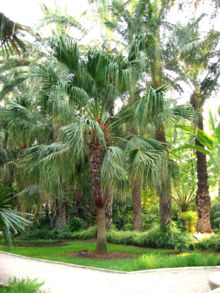Livistona chinensis: Difference between revisions
Full reference as Bermuda invasive species |
|||
| Line 12: | Line 12: | ||
| species = '''''L. chinensis''''' |
| species = '''''L. chinensis''''' |
||
| binomial = ''Livistona chinensis'' |
| binomial = ''Livistona chinensis'' |
||
| binomial_authority = ([[Nikolaus Joseph von Jacquin|Jacq.]]) [[Robert Brown (botanist)|R.Br.]] ''ex'' [[Carl Friedrich Philipp von Martius|Mart.]]<ref name=WCSP>{{WCSP | 114913 | accessdate = 6 March 2017 }}</ref> |
| binomial_authority = ([[Nikolaus Joseph von Jacquin|Jacq.]]) [[Robert Brown (botanist, born 1773)|R.Br.]] ''ex'' [[Carl Friedrich Philipp von Martius|Mart.]]<ref name=WCSP>{{WCSP | 114913 | accessdate = 6 March 2017 }}</ref> |
||
| synonyms = |
| synonyms = |
||
*''Chamaerops biroo'' {{Au|Siebold ''ex'' Mart.}} |
*''Chamaerops biroo'' {{Au|Siebold ''ex'' Mart.}} |
||
Revision as of 20:01, 6 March 2017
| Fountain palm Chinese fan palm | |
|---|---|

| |
| Scientific classification | |
| Kingdom: | |
| (unranked): | |
| (unranked): | |
| (unranked): | |
| Order: | |
| Family: | |
| Genus: | |
| Species: | L. chinensis
|
| Binomial name | |
| Livistona chinensis | |
| Synonyms[1] | |
| |
Livistona chinensis, the Chinese fan palm[2] or fountain palm,[3] is a species of subtropical palm tree of east Asia. It is native to southern Japan, Taiwan, the Ryukyu Islands, southeastern China and Hainan. It is also reportedly naturalized in South Africa, Mauritius, Réunion, the Andaman Islands, Java, New Caledonia, Micronesia, Hawaii, Florida, Bermuda, Puerto Rico and the Dominican Republic.[1][2]
Livistona chinensis can attain heights of about 9 to 15 m (30 to 50 ft) and a spread of 4 m (12 ft). The leaves are fan shaped.[2]
Cultivation
The palm is cultivated as an ornamental tree in gardens and conservatories.[4]
This plant can become a weed, or in some ecosystems an invasive species, in places such as Bermuda,[4] Florida wetlands and on some Caribbean Islands.
References
- ^ a b c "Livistona chinensis". World Checklist of Selected Plant Families (WCSP). Royal Botanic Gardens, Kew. Retrieved 6 March 2017.
- ^ a b c "Chinese Fan Palm". Palm Trees. Archived from the original on 17 March 2012. Retrieved 6 March 2017.
- ^ USDA, NRCS (n.d.). "Livistona chinensis". The PLANTS Database (plants.usda.gov). Greensboro, North Carolina: National Plant Data Team. Retrieved 6 March 2017.
- ^ a b "Chinese Fan Palm". Department of Environment and Natural Resources (Bermuda). Retrieved 6 March 2017.
